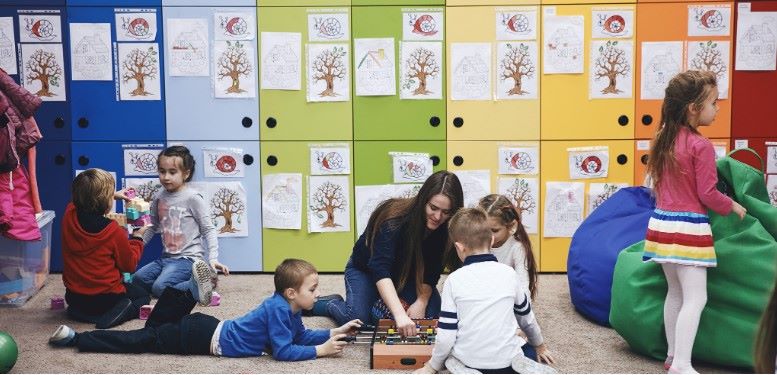Before I turn on my Zoom camera, I prepare my face. Not by smoothing away emotion, but by reminding myself to animate it. My face, by default, shows little. I carry passion in everything I do, yet my features rest in stillness, not by choice but design. Beneath that blankness, emotions do surge—a riptide of thought and feeling, cloaked by a mask that isn’t meant to deceive, but which simply exists.
Adjusting my expression is perhaps the most stressful part of any meeting for me—second only to the moment of introduction, when I must quickly decipher whether I’m expected to return a fist bump, offer a handshake, or brace for the dreaded hug.
I’m not socially awkward, at least not especially so. But when it comes to reading social cues in real-time? I’m completely, unequivocally socially blind.
Thankfully, this is a Zoom call, and even more thankfully, I am speaking with Dr. Whitney Kleinert, director of the North Georgia Autism Foundation located at 1423 Washington Street, in Clarkesville, Georgia.

In a modest office nestled somewhere between the foothills and the fast-growing corridors of North Georgia, quiet revolutions are underway. The North Georgia Autism Foundation, founded by Tripp Ritchie and now led by clinical psychologist Dr. Kleinert, is not a sprawling institution with million-dollar campaigns or gilded partnerships. It is something far rarer in the landscape of developmental support services: nimble, sincere, and radically accessible.
NGAF offers free or low-cost diagnostic evaluations, clinical consultations, and family-centered guidance for Autistic individuals of all ages. In a region where the cost of an autism evaluation can climb to $4,000—and where access to specialists is often limited to families with time, transportation, and excellent insurance—this kind of care is, quite literally, life-changing.
Dr. Kleinert, the volunteer executive director, often fields the most human questions: “My daughter is three and still hasn’t spoken. What should we ask her pediatrician?”
“My teenage son wants to go on a date but doesn’t know how. Can you help?”
NGAF answers these calls not with bureaucracy but with compassion and evidence-based insight. The foundation runs on a patchwork of community funding and private donations. Whether it’s a preschooler at a loss for words or an adult looking to advocate for themselves in the workplace, NGAF meets them where they are—and walks with them from there.
Far from the outdated institutionalization models or the polished but impersonal initiatives of national nonprofits, NGAF does the slower, harder work: empowering families, training professionals, and emphasizing self-advocacy.
This approach to Autism marks yet another chapter in the long evolution of neurodiversity healthcare—an arc that, in the United States, began with the work of Dorothea Dix. Her 19th-century campaign for the humane treatment of individuals with mental and developmental differences helped crack open the door to a more compassionate understanding. However, this revolution has been anything but linear. It resembles a line graph—marked not by steady ascent, but by erratic spikes and plunging valleys. For every moment of progress, there have been regressions: waves of institutionalization, misdiagnosis, stigma, and exclusion. And yet, the highs grow higher. Each new phase of understanding—however hard-won—brings us closer to a world where Autistic individuals are not merely accommodated but embraced.
RELATED Monthly coffee chat offers support to autistic kids and their families
Autism and education in the early aughts
As a child of the early aughts, I remember elementary school all too well. I struggled to adapt—mismatched with the rhythms of a public school classroom. My teacher didn’t just lack sympathy for her strange but well-behaved Autistic student—she actively resented me. Her disdain sharpened every flicker of inadequacy I already felt.
Worse still were the weekly, mandatory visits to the school therapist—a woman who felt like the Flanderized version of a sitcom guidance counselor. With oversized spectacles and long tie-dye skirts, she cut a whimsical, if slightly bewildering figure. Her voice—soft, theatrical, and overly sweet—grated on me even as a ten-year-old.
She insisted on speaking to me through a whale puppet named—absurdly—Mr. Porpoise. Mortified and confused, I refused to respond. She told my teacher I lacked social skills and handed me a copy of The Last of the Really Great Whangdoodle, along with lectures about creating “happy bubbles.”
I had just finished Flowers for Algernon and Of Mice and Men. I raised an internal, literary eyebrow. The whole experience felt less like therapy and more like a parody—insult stacked atop injury.
I wasn’t alone. During that period, Autism Spectrum Disorder (ASD) diagnoses were rising, with the Centers for Disease Control and Prevention (CDC) estimating that approximately 1 in 150 children were identified with ASD in 2000. This surge in diagnoses highlighted a pressing need for educational systems to adapt. However, in the era of the No Child Left Behind policy, many schools resorted to punitive measures and segregation into special education settings.
Data from that era reveals concerning trends. Students with disabilities, including those with ASD, faced disproportionately high rates of disciplinary actions. For instance, the National Longitudinal Transition Study-2 indicated that approximately 33% of students with disabilities experienced suspension or expulsion, compared to 21% of their non-disabled peers. Moreover, research from the early 2000s highlighted that African American students with Autism were disproportionately segregated into restrictive special education classes.
When support becomes control: How some parents and programs still get Autism wrong
Schools and state agencies continue to place Autistic students in restrictive environments, often far from home and without clinical oversight. In Washington State, for example, officials reported in 2021 that nearly half of the students receiving special education services in residential facilities carried an Autism diagnosis. Most of those students lived out of state and were removed from their communities and support systems.
National data reveals a broader pattern. While approximately 40 percent of Autistic students spent most of their day in general education classrooms in 2018, many others remained in segregated or highly structured programs. A subset of these students, though poorly tracked, enter therapeutic boarding schools or so-called “troubled teen” programs—settings that often prioritize compliance over care.
Researchers and advocates have criticized these placements’ lack of federal oversight and transparency. Without reliable data, policymakers struggle to assess outcomes or ensure ethical treatment. What remains is a fragmented system where too many Autistic children fall through the cracks—not for a lack of diagnosis, but a lack of direction.

https://www.pexels.com/photo/a-person-with-black-handcuffs-7773266/
Therapeutic boarding schools, often billed as a last resort for struggling teens, have quietly become a catch-all solution for Autistic youth who exhibit behaviors that fall outside the norm. Dr. Kleinert and I discuss troubling patterns within these institutions. We lament how boys are overrepresented in these programs, frequently labeled as aggressive and subjected to physical restraints and punishment. She emphasizes how behavioral consequences tend to exacerbate Autistic symptoms.
This aligns with the testimony of a former counselor of a Georgia troubled teen program, who describes how some students are force-fed meal replacements—cold chickpeas and spinach among them—regardless of known sensory sensitivities that can trigger vomiting or physical distress. If they vomit, staff often replace the meal with the exact same menu and instruct the child to try again. The process repeats until the student either finishes the food or goes without.
In some cases, staff store uneaten meals overnight and re-serve them until the student complies. Concerning female students, the former counselor explained that Autistic girls, especially inclined toward eating disorders and gender identity questions, a distinct experience within the Autistic female community, often faced a different kind of punishment: “friendship bans.” This disciplinary measure prohibits peer interaction with anyone staff assumes the girl may have a romantic interest in, effectively weaponizing isolation.
Parents, often desperate to help their children, find themselves choosing between unsafe environments and inadequate local resources. “These are not easy decisions,” Dr. Kleinert said. “But we need to ask whether the intervention helps the child grow—or simply silences them.”
She urges families to consider alternatives before committing to out-of-home placement. “I always recommend the least restrictive path first: consistent therapy with a trusted provider, family counseling, and approaches like Collaborative & Proactive Solutions, which help align the language and expectations between caregivers and the child,” she explained.
She notes that hospital-based care may be appropriate in acute cases, but even then, she stresses the importance of day programs—particularly those built for Autistic individuals, not just neurotypical models retrofitted to seem inclusive. She warns that some private schools offer tailored environments, but ensuring they’re not just overpriced daycares is critical.
Her message to parents considering a therapeutic placement is clear: “This can be a life-altering decision—for better or for worse. Get multiple clinical opinions. Visit the facility. And above all, listen to your child’s voice in the process.”
She issues a warning about the booming industry that profits from parental fear: “Education consultants often operate under the guise of guidance, but they often have financial ties to specific programs. Prioritize your child’s opinion, and consult with a therapist and a licensed psychologist who understands your child, not someone selling you a solution.”
Put simply, the town eccentric’s magic beans grow nothing but giant weeds. For families told they have only one option—send their child away—Dr. Kleinert offers something radical: a second opinion rooted not in punishment, but in understanding. While the past century of disability reform has improved the lives of many with neurodivergence, it’s important to recognize that countless Autistic individuals still lack agency and are placed in highly restrictive environments where outdated and harmful practices persist.

https://www.pexels.com/photo/man-interviewing-the-woman-5439137/
Adult Autism in the workplace
Corporate allyship often sounds great in a press release. TikTok bios featuring puzzle pieces and “neurodivergent-affirming” tags are everywhere. April brings waves of awareness campaigns, polished branding, and social media posts declaring support for Autistic individuals.
But one stark truth remains: the unemployment rate for Autistic people is still devastatingly high. Despite all the ribbons and rhetoric, this discrepancy reveals a difficult truth—one that economists call a “revealed preference.” Employers say they support neurodivergent hiring. But when it comes to actually interviewing, hiring, accommodating, and retaining Autistic employees, many fall short.
Dr. Kleinert and I spoke at length about the staggering unemployment rate among Autistic adults—a crisis that too often goes unaddressed. A 2021 study published in the National Library of Medicine found that roughly 40% of adults with an autism diagnosis are unemployed.
Because employers often like the idea of inclusion more than the work of inclusion, that includes learning what Autistic employees need to succeed and being flexible in measuring success.
Dr. Kleinert explains that it means asking questions like:
● What kind of work is meaningful to this individual?
● Does this role allow them to work in their strengths?
● Are we making assumptions about what “professionalism” looks like?
Too often, Autistic teens are pushed into jobs that feel deeply misaligned with their interests and sensory needs. A young person who loves animals might end up forced into a retail cashier role, simply because it’s “what’s available” or “teaches responsibility.” It’s a mismatch from the start.
Dr. Kleinert also emphasizes the difficulty of interviews. For many Autistic people, interviews are not a measure of ability—they’re a test of how well we can act like someone else for 30 minutes. They often measure charisma, eye contact, and unscripted small talk, little of which correlates with job performance.
By shifting their approach, management better distinguishes the truly qualified from the unqualified and gives Autistic workers a fighting chance. That means focusing on outcome-based assessments rather than presentation-based first impressions. Employers should place greater weight on resumes, references, and practical trials, which often reveal far more about a candidate’s potential than a traditional interview ever could.
Conclusion
Before every Zoom meeting, I remind my face to perform—not to hide who I am but to help others see me clearly. That small act—so practiced and exhausting—sums up the reality many Autistic adults live with: navigating a world that still values appearance over understanding, performance over presence.
However, places like the North Georgia Autism Foundation offer a different model rooted not in show, but in substance. Dr. Kleinert and her team don’t just diagnose; they listen. They meet families in moments of crisis, not with prescriptions, but with perspective. They remind us that being Autistic isn’t the problem—the systems we’re asked to survive in are.
Real inclusion isn’t viral. It’s not performative. It’s quiet, consistent, and committed. It looks like asking better questions, making space for different ways of thinking, and refusing to settle for a one-size-fits-all solution.
Progress may not be perfect, but foundations like NGAF prove it’s possible. And in a world where too many are still told to go away, the power of being told, “You can stay—just as you are,” cannot be overstated.







